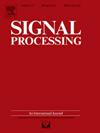Residual-optimized general linear chirplet transform: A method for time–frequency feature extraction
IF 3.4
2区 工程技术
Q2 ENGINEERING, ELECTRICAL & ELECTRONIC
引用次数: 0
Abstract
Time–frequency analysis (TFA) is an essential sub-area in signal processing, and many of its methods are widely used in various fields. Current methods cannot address the multi-component signals well when facing strong noise, which makes it difficult to describe the accurate time–frequency trajectory. This paper proposes a TFA method named residual optimized general linear chirplet transform (ROGLCT) to achieve better time–frequency energy concentration and robustness. Firstly, the beetle antennae search (BAS) algorithm with Rényi entropy was utilized as the fitness function to optimize GLCT parameters. Then, the maximum energy modes of the optimized GLCT time–frequency distribution are iteratively separated. Finally, the separated modes are squeezed to rebuild the spectrum. Numerical simulation and actual signals (echolocation and vibration signals) verify the proposed method’s effectiveness. Compared with other advanced methods, ROGLCT can overcome noise interference and depict clear, energy-concentrated time–frequency representation (TFR) in complex environments.
残差优化广义线性小波变换:一种时频特征提取方法
时频分析(TFA)是信号处理的一个重要分支,它的许多方法被广泛应用于各个领域。现有的方法在面对强噪声时不能很好地处理多分量信号,难以准确描述时频轨迹。本文提出了一种残差优化广义线性小波变换(ROGLCT)的TFA方法,以达到较好的时频能量集中和鲁棒性。首先,利用r尼米熵的甲虫天线搜索(BAS)算法作为适应度函数对GLCT参数进行优化;然后,迭代分离优化后GLCT时频分布的最大能量模态。最后,对分离的模进行压缩重建频谱。数值仿真和实际信号(回声定位和振动信号)验证了该方法的有效性。与其他先进方法相比,ROGLCT可以克服噪声干扰,在复杂环境中描绘清晰、能量集中的时频表示(TFR)。
本文章由计算机程序翻译,如有差异,请以英文原文为准。
求助全文
约1分钟内获得全文
求助全文
来源期刊

Signal Processing
工程技术-工程:电子与电气
CiteScore
9.20
自引率
9.10%
发文量
309
审稿时长
41 days
期刊介绍:
Signal Processing incorporates all aspects of the theory and practice of signal processing. It features original research work, tutorial and review articles, and accounts of practical developments. It is intended for a rapid dissemination of knowledge and experience to engineers and scientists working in the research, development or practical application of signal processing.
Subject areas covered by the journal include: Signal Theory; Stochastic Processes; Detection and Estimation; Spectral Analysis; Filtering; Signal Processing Systems; Software Developments; Image Processing; Pattern Recognition; Optical Signal Processing; Digital Signal Processing; Multi-dimensional Signal Processing; Communication Signal Processing; Biomedical Signal Processing; Geophysical and Astrophysical Signal Processing; Earth Resources Signal Processing; Acoustic and Vibration Signal Processing; Data Processing; Remote Sensing; Signal Processing Technology; Radar Signal Processing; Sonar Signal Processing; Industrial Applications; New Applications.
 求助内容:
求助内容: 应助结果提醒方式:
应助结果提醒方式:


